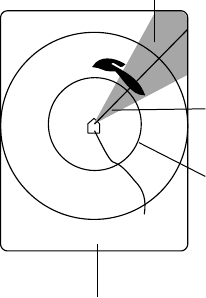
3-3
3.2 Detecting Fish Schools Aurally
Sometimes you may be preoccupied with other tasks and unable to concentrate
on watching the sonar picture. In such cases it would be a good choice to use
the audio function. This function enables you to monitor echoes from fish
schools and bottom through the built-in speaker.
After you’ve become accustomed to monitoring fish aurally, you should be able
to detect a fish school from a range longer than you can detect it on the screen.
In addition you may judge whether the fish school is approaching or going away;
the tone becomes higher when the school is approaching and lower when the
school is going away.
1. Operate the trackball to place the trackball mark on the direction you want to
monitor through the speaker. (If the trackball mark is placed on the own ship
mark when the [R/B] key is pressed, the range and bearing marks and range
and bearing marks data are erased.)
2. Press the [R/B] key. The bearing mark appears on the bearing selected with
the trackball mark. Listen to echoes through the loudspeaker. You may adjust
the volume of the loudspeaker with AUDIO VOLUME on the SONAR menu.
3. To change aural coverage area, do the following:
a) Press the [MENU] key to open the menu.
b) Use the [RANGE] control to choose [MENU MODE] at the top of the screen.
c) Use the [GAIN] control to choose SONAR.
d) Use the [RANGE] control to choose AUTO TRAIN.
e) Use the [GAIN] control to choose ON.
f) Use the [RANGE] control to choose TRAIN SECTOR.
g) Use the [GAIN] control to choose train sector among ±10°, ±20°, ±40° and
±60°.
Range and bearing marks data
Range Mark
Bearing Mark
R 400 B 45S*
Train Sector
* = Relative bearing format may be chosen
with OTHER MARKS in the MARKS menu.
h) Press the [MENU] key to close the menu. Then, automatic training starts,
centered on the bearing mark.
To turn off automatic training, choose OFF at step e).


















